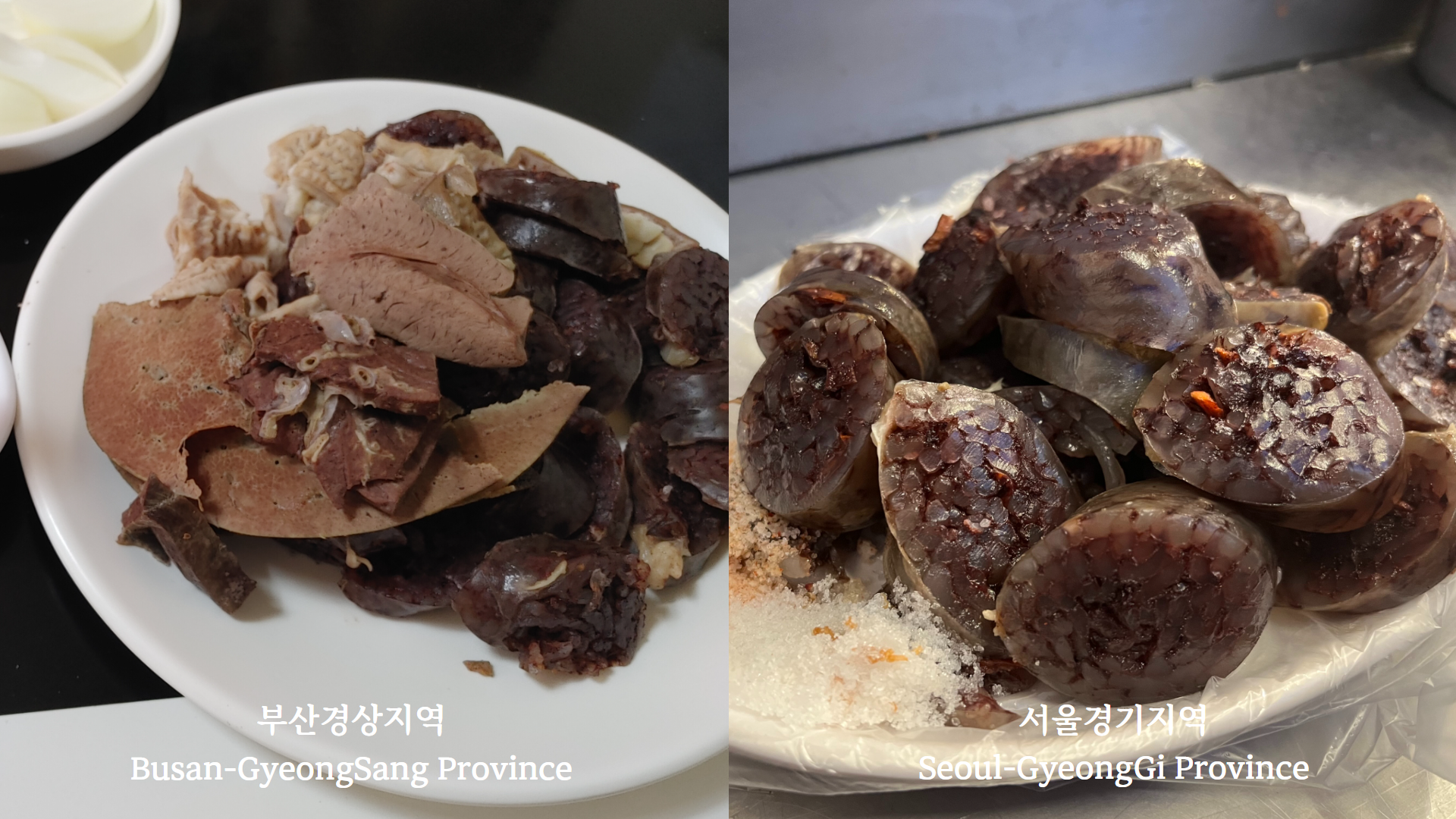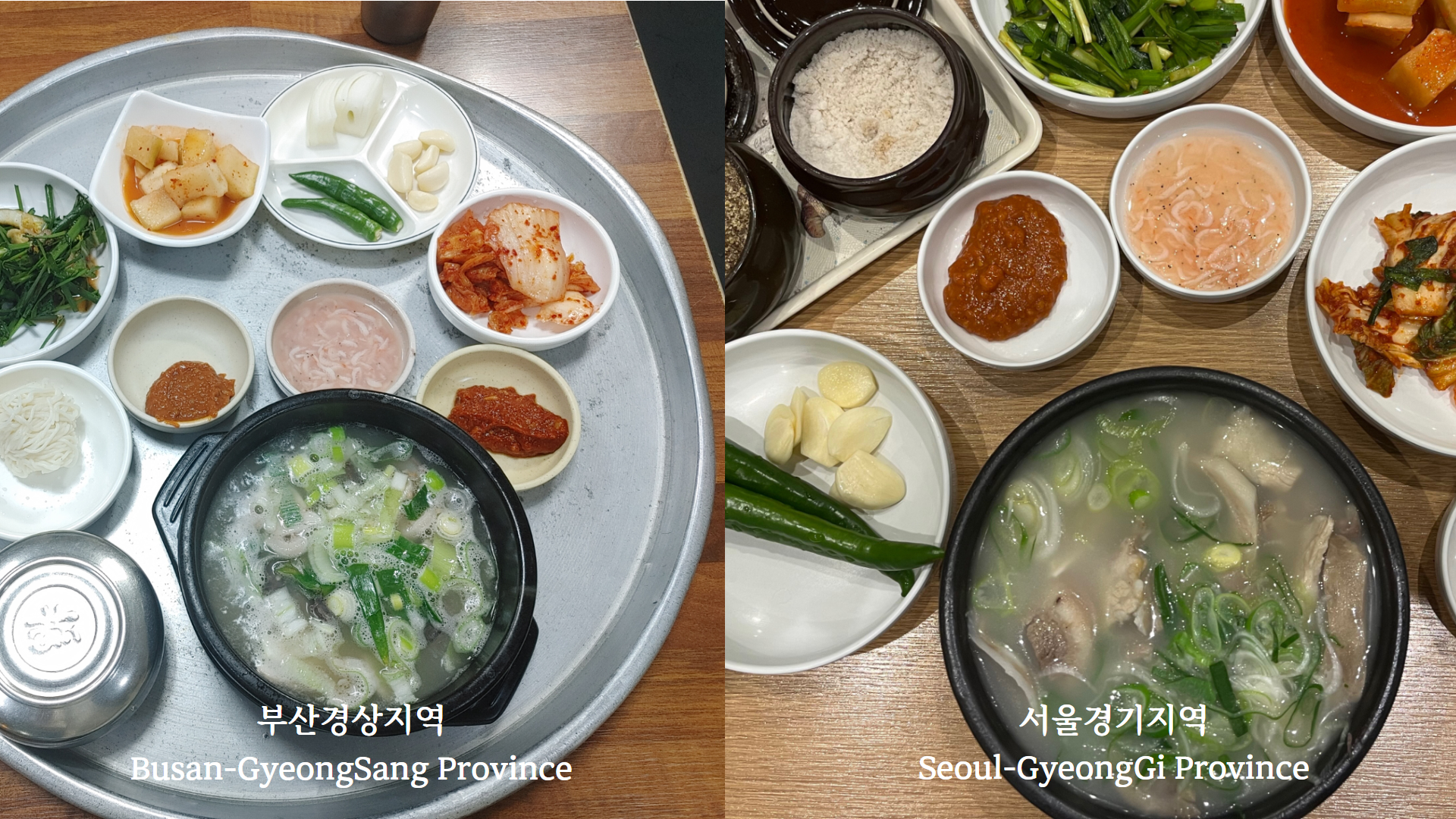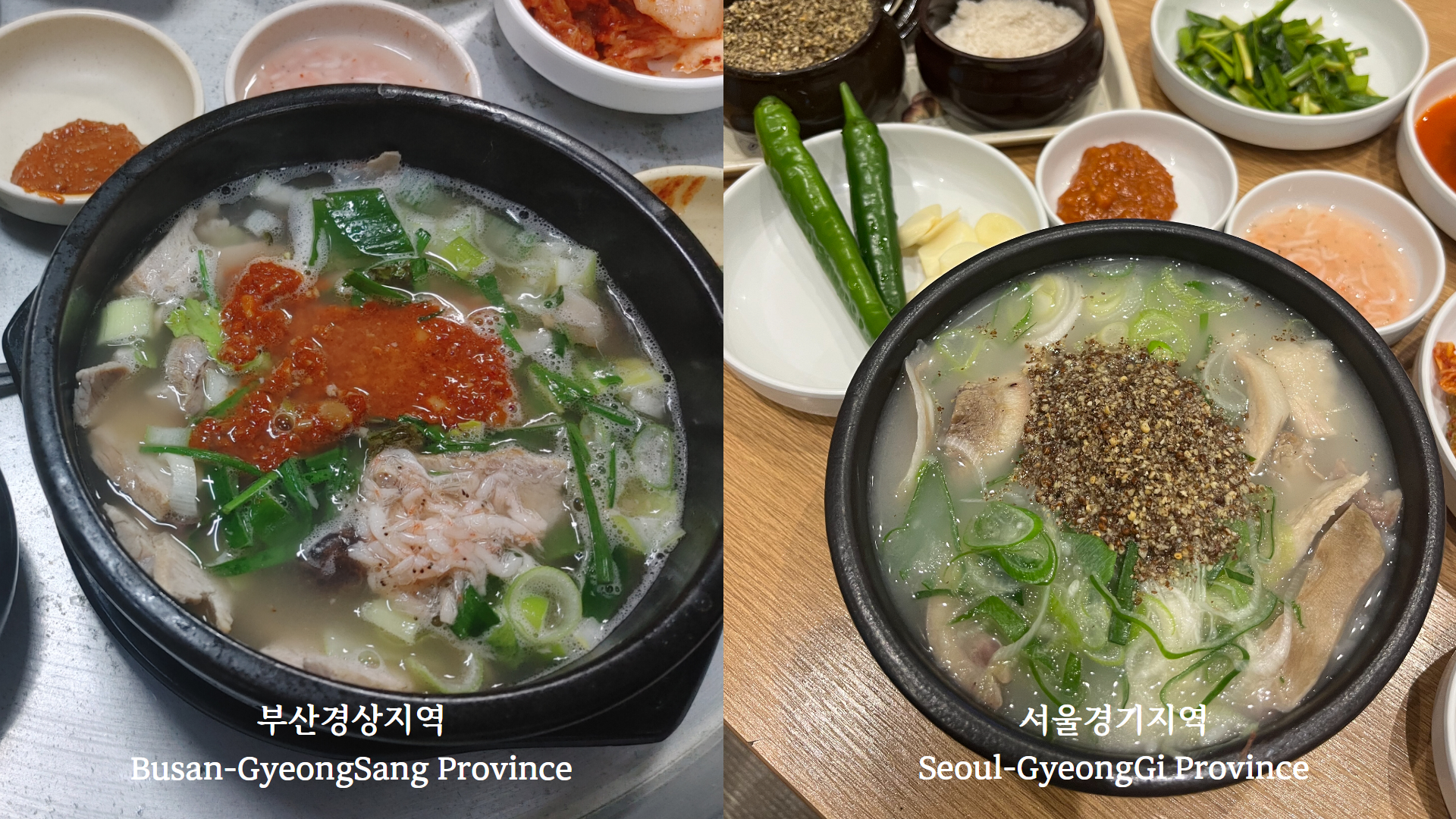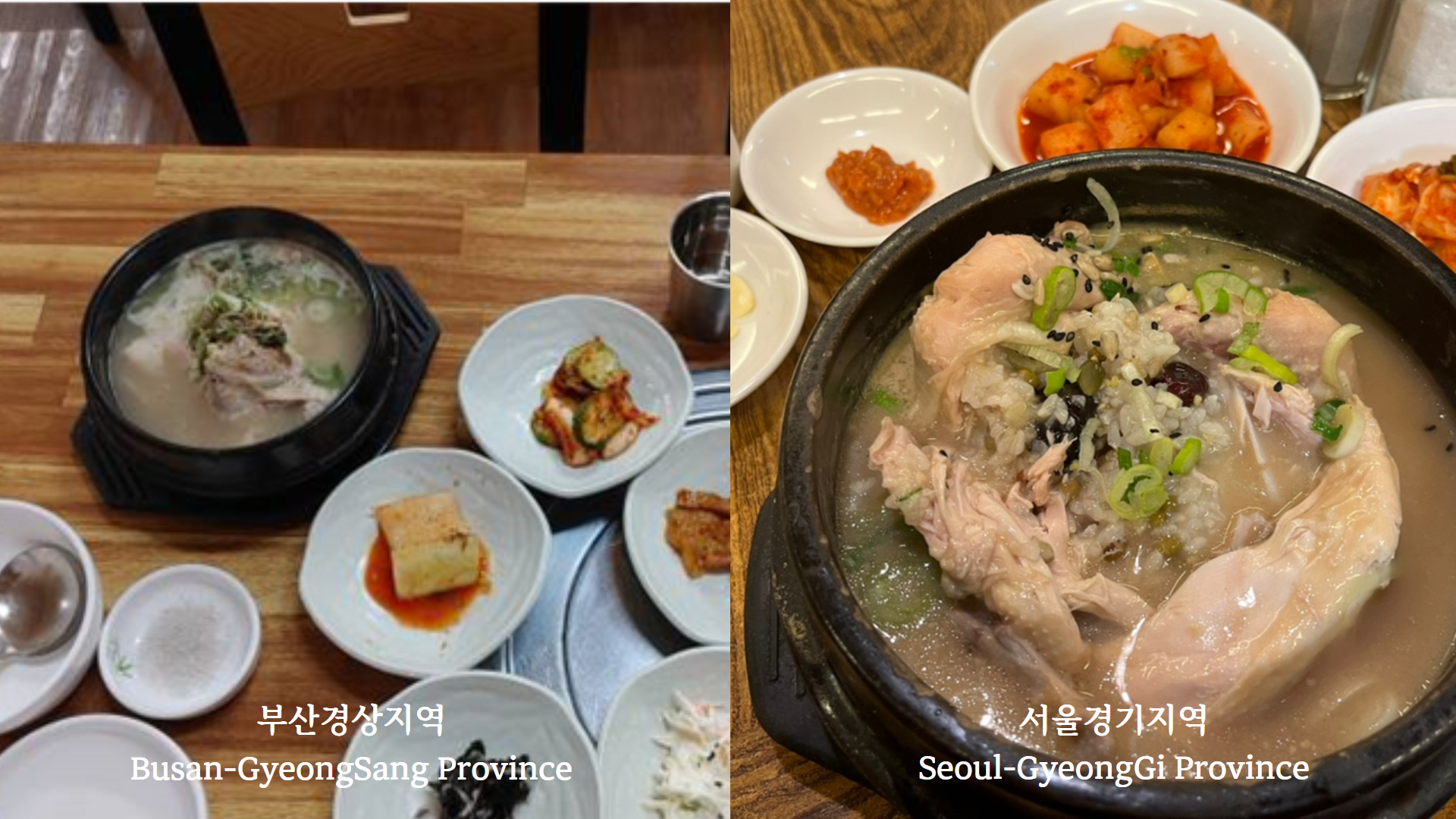Seoul VS. Busan, Same Food Different Presentation
서울 VS. 부산, 같은 음식, 다른 방식
Seoul and Busan, these two cities that have always been compared, either worldwide or by expats who live in South Korea. I used to live in Seoul from 2012 until 2020, then I moved to Gimhae City from 2021~2022 for two years, and have lived in Busan since February 2023.
서울과 부산, 이 두 도시는 한국에 사는 외국인들이나 전세계로부터 항상 비교되어 왔다. 나는 2012년부터 2020년도 까지 서울에 거주했고, 2021년부터 22년까지 2년간 김해시로 이사하여 지냈고, 2023년도 2월부터 부산에서 지내고 있다.
Busan has beaches, lighthouses, and coastal trails as well as busy metropolitan districts such as Seomyeon, and the Centum City area. However, this time I would like to share my experience with food in Seoul and Busan.
부산은 바쁘게 돌아가는 대도심지인 서면과 센텀지구 외에도 해수욕장, 등대, 해안철도 등 많은 것들이 있지만, 이번에는 서울과 부산에서 내가 경험한 음식에 대한 경험을 나누고자 한다.
 Sundae Blood Sausage 순대
Sundae Blood Sausage 순대 Sundae is a blood sausage dish that is more popular as a street food or known as one kind of Bunsik. Sundae is made from cow or pig’s intestines. The meat is steamed and stuffed with various ingredients such as blood, minced meat, rice, and vegetables. There are many kinds of Sundae based on the region, but this time I would like to emphasize the difference in the serving between Seoul- Gyeonggi-do province, and Busan- Gyeongsangnamdo province.
순대는 길거리 음식 이나 분식의 한 종류로 더 잘 알려진 피가 들어있는 삶은 소세지 요리이다. 순대는 소나 돼지의 내장으로 만들어잔다. 다진 고기, 쌀, 그리고 야채와 같은 다양한 재료들과 함께 채워 쪄먹는 음식이다. 순대는 지역에 따라 여러 종류가 있지만 이번에는 서울-경기도와 부산-경남지역에서 제공하는 방식의 차이에 대해 집중해 보려한다.
In Busan and the Gyeongsangnam Province area, Sundae is served with samjang. I am sure you are not foreign to samjang. Samjang is a thick spicy paste made of fermented soybeans, red chili paste, sesame oil, onion, garlic, and green onions. So, people who live Busan-Gyeongsangnam Province eat sundae with samjang just like when we eat Korean barbeque. Meanwhile, in Seoul and Gyeonggi Province, Sundae is served with salt. Therefore, they put a bit of salt on Sundae and eat it.
부산과 경상남도 지역에서는 순대와 쌈장이 함께 나온다. 나는 당신이 쌈장을 모르지 않을 것이라고 확신한다. 쌈장은 콩, 고추장, 참기름, 양파, 마늘, 파를 발효시켜 만든 걸쭉한 매운 장이다. 그래서 부산, 경남에 사는 사람들은 우리가 한국식 바비큐를 먹을 때와 마찬가지로 쌈장을 곁들여 순대를 먹는다. 한편, 서울과 경기도에서는, 순대를 소금과 함께 준다. 따라서, 그들은 순대를 소금에 조금 찍어서 먹는다.
When I had Sundae for the first time in Gimhae city, Gyeongsangnam Province, I was confused as to why they gave me ssamjang when I order Sundae, and they told me that they do not have salt. It did not take me a long time to adjust to this new style of enjoying Sundae. I like both ways and love having sundae in Busan more, because the portion is bigger in the south, and in some places they give you fresh cuts of onion to accompany your sundae. How generous!
내가 처음 경상남도 김해로 와서 순대를 시켜 먹었을때, 소금이 없다며 쌈장과 순대를 주는 것 때문에 혼란스러웠다. 하지만, 순대를 먹는 새로운 방식에 적응하는데 오래 걸리지 않았다. 나는 두가지 방법 모두 좋아하지만, 부산스타일로 순대 먹는 것을 조금 더 좋아한다. 왜냐하면, 쌈장을 신선한 양파와 함께 곁들여 주기는 비중이 남부지역과 몇몇 지방에서는 더 높기 때문이다. 얼마나 친절한가!

Dwaeji Gukbab Pork and Rice Soup 돼지국밥
The history of Pork and Rice in Seoul: “Dwaeji Gukbab” started during the Korean War that happened from 1950 to 1953. Originally, this dish was created in Busan, first by North Korean refugees who used pork bones that were discarded by the U.S. military, and then it spread to the entire Gyeongsang Province, and finally to the entire country.
서울에서의 돼지국밥 역사는 1950년부터 1953년까지의 한국전쟁에서 비롯되었다. 원리 이 요리는 미군이 버린 돼지 뼈를 사용한 피란 내려온 북한지역 사람들에 의해 부산에서 처음 만들어진 음식이고, 이후 경상도 전역으로 펴져 나갔고, 마침내 전국으로 확산 되었다.
The dish is a broth with meat slices in it. The broth is white and milky, meanwhile, the meat can be Sundae blood sausage blood, Naengjang offal (organs), and other parts of the pig. This dish is usually accompanied by a couple of kinds of Kimchi, such as cabbage kimchi, radish Kimchi. Other accompaniments include green onions, slices of garlic, and big chopped onions & chili to dip with samjang, red pepper paste, plus lest not we forget fermented shrimp, and light white noodles.
이 요리는 육수에 편고기를 넣은 것이다. 육수는 우윳빛깔의 흰색을 띄며, 고기는 순대, 내장과 돼지의 다른 부위를 사용한다. 이 요리에 몇몇 김치 종류의 하나인 보통 배추김지, 무김치, 파, 마늘편, 썬 양파과 양념장, 쌈장, 고추장을 넣을 수 있고, 추가로 발효된 새우젓과 가는 소면도 첨가하여 있을 수 없는 맛을 만든다.

What you do is, you can put the white noodles and the rice into the hot boiling bowl. After that, you can add red pepper paste if you like spicy broth, or fermented shrimp to spice up the flavor. From time to time, you can get chili, slices of garlic, and big chopped onions and eat them raw like they are presented, or dip it as much or as little as you like in the samjang.
이 음식을 먹는 이는 하얀 소면과 밥을 뜨거운 뚝배기에 넣는 것이다. 혹시 자극적인 맛을 좋아한다면 고추 양념장이나 발효된 새우젓을 추가하여 풍미를 더하면 된다. 국밥과 함께 나오는 생 고추, 마늘편, 썬 양파를 원하는 만큼 쌈장에 찍어서 먹으면 된다.
There is a slight difference in the serving Dwaeji Gukbab Pork & Rice Soup between Seoul-Gyeonggi Province and Busan- Gyeongsangnam Province. In Seoul and Gyeonggi Province, they always have Deulkkae-garu a.k.a: perilla seeds powder. They just look like the picture on the right. Perilla is also known as Kkaennip, a vegetable with a unique smell. The leaves can be eaten as side dishes and the seeds are roasted and used as seasoning in the cooking or when having soupy meals such as Dwaeji Gukbab Pork Rice Soup, Sundae Gukbab Blood Sausage soup, Chueottang loach soup, Gamja Ungsimi potato dough soup, which is a Gangwon province specialty, and Ppyeohaejangguk spicy beef and bone stew. Deulkkae is sometimes mistranslated as “wild sesame”.
서울-경기권과 부산-경남권에서 돼지국밥을 먹는 방식은 조금 다르다. 서울-경기권에서는 들깨 가루를 항상 먹는다. 오른쪽 그림에 있는 것과 같이 생겼고, 특유의 향이 나는 채소인 깻잎이라고도 알려져 있다. 깻잎은 반찬으로 먹을 수 있고, 씨앗은 볶아서 돼지국밥, 순대국밥, 추어탕, 강원도 특산물인 감자를 반죽하여 만든 감자옹심이국, 뼈해장국과 같이 깊은 맛이 나는 국물요리에 향신료 처럼 사용한다. 들깨는 때때로 야생 참깨로 잘못 번역한 채 표기되어 있기도 하다.
To elaborate on the difference in taste, let me share my experience. Hence, when I first tried Dwaeji Gukbab Pork and Rice Soup in Gimhae City, I was confused as to why there was no Deulkkae-garu perilla seeds powder. In my personal opinion, perilla seeds powder makes the soup crispier. My method for eating any soup that is served in the metal bowl is to pour some of the broth into the rice and I like to add perilla seeds powder. The rice will become a bit like porridge (kongee) and with perilla seeds powder, it hugs my tummy. I must admit that the quantity of meat that is served in Busan-Gyeongsangnam Province is way more than in Seoul and Gyeonggi Province.
내 경험에 빗대어 먹어본 맛의 차이에 대해 설명하고자 한다. 김해시에서 처음 돼지국밥을 먹었을 때, 들깨가루가 없는 것이 의아했다. 개인적인 의견으론, 들깨가루가 국물의 맛을 훨씬 더 아삭하게 해준다. 내가 먹는 방법은 밥이 든 스테인레스 그듯에 국물과 들깨가루를 조금 넣어 먹는 것이다. 국과 들깨가루가 들어가면 밥이 약간 죽 처럼 되는데, 이는 배를 감싸준다. 부산-경남식 돼지국밥이 서울-경기식 보다 훨씬 많은 양의 고기를 넣어준다는 것은 부인할 수 없는 사실이다.

Samgyettang(Chicken Ginseng Soup) 삼계탕
As Samgyetang Chicken Ginseng Soup is not an original Busan dish, I will skim through this meal. Samgyetang is a bowl of soup with a whole-boiled chicken in it. Inside the chicken, you will find glutinous rice, garlic, jujubes, and ginseng. The soup itself is milky and known to be enjoyed during the summer, especially in July and August. The original name of this is Chicken Ginseng Soup, but was in a different order, Gyesam-tang. However, since the 1960s, people began to gradually put ginseng inside the chicken instead of using powder. Therefore, the name has changed to Samgyetang to highlight the importance of using ginseng as one of the ingredients. gye means chicken in Hanja (Korean Chinese Characters) and tang means soup.
삼계탕이 부산 고유의 음식이 아니기에 대략적으로만 짚고 가려한다. 삼계탕은 닭을 통째로 삶아 그릇에 담아주는 음식이다. 닭 안에는 찹쌀, 마늘, 대추, 인삼 등이 들어 있습니다. 국물 자체가 뽀얗고, 여름, 특히 7~8월에 즐기는 것으로 알려져 있다. 이 것의 원래 이름은 닭 인삼탕이지만, 순서를 달리하여 '계삼탕'이라고도 불렀다. 하지만, 1960년대 부터, 사람들은 분말을 사용하는 대신에 점차 인삼을 닭 안에 넣기 시작했습니다. 그리하여, 인삼을 재료로 사용하는 것의 중요하게 강조하기 위해 이름이 삼계탕으로 바뀌었습니다. 계는 한자로 닭을 의미하고, 탕은 수프를 의미합니다.
The differences between Chicken Ginseng Soup in Seoul and Busan that I experienced is that the broth in Seoul is milkier and the taste is very pure or bland. You can add pepper to the bowl as you like. But in Busan & Gimhae, the broth is slightly brown and more flavorful, so you do not need to add pepper.
The rest, such as the side dishes, is the same: radish kimchi, cabbage kimchi, and garlic, and depending on the restaurant some give more side dishes and a shot of ginseng soju and some do not give it any more. The dining experience is the same, in that you dip the chicken into the salt.
내가 경험한 서울식 삼계탕과 부산식의 차이점은 서울의 육수가 더 짜며 맛이 매우 순수하거나 담백하다는 것이다. 취향에 따라서 그릇에 후추를 원하는 대로 추가할 수 있다. 하지만 부산과 김해는 국물이 약간 더 갈색을 띄고 풍부한 맛이 나기 때문에 후추를 넣지 않아도 된다.
나머지 밑반찬 거의 다 똑같다. 무김치, 배추김치, 마늘 등이 제공되고, 식당에 따라 반찬을 더 주거나, 인삼 소주 한 잔을 주는 곳도 있고 안 주는 곳도 있습니다. 닭고기를 소금에 찍어 먹는다는 점은 어느 지역에서나 동일했다.


